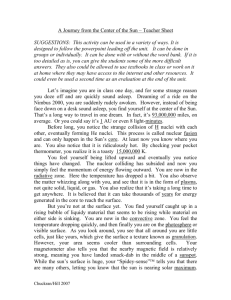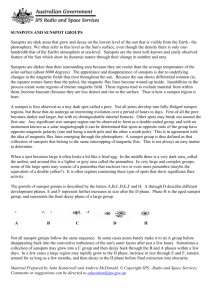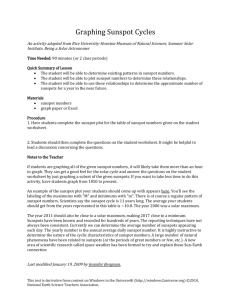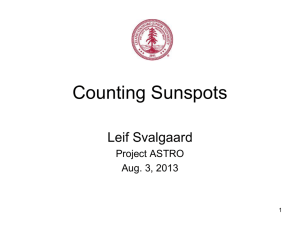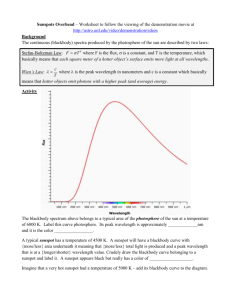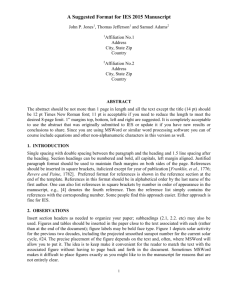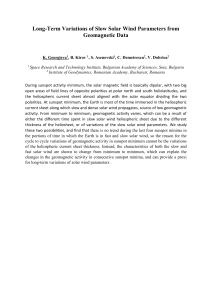SomeR12Info060323
advertisement
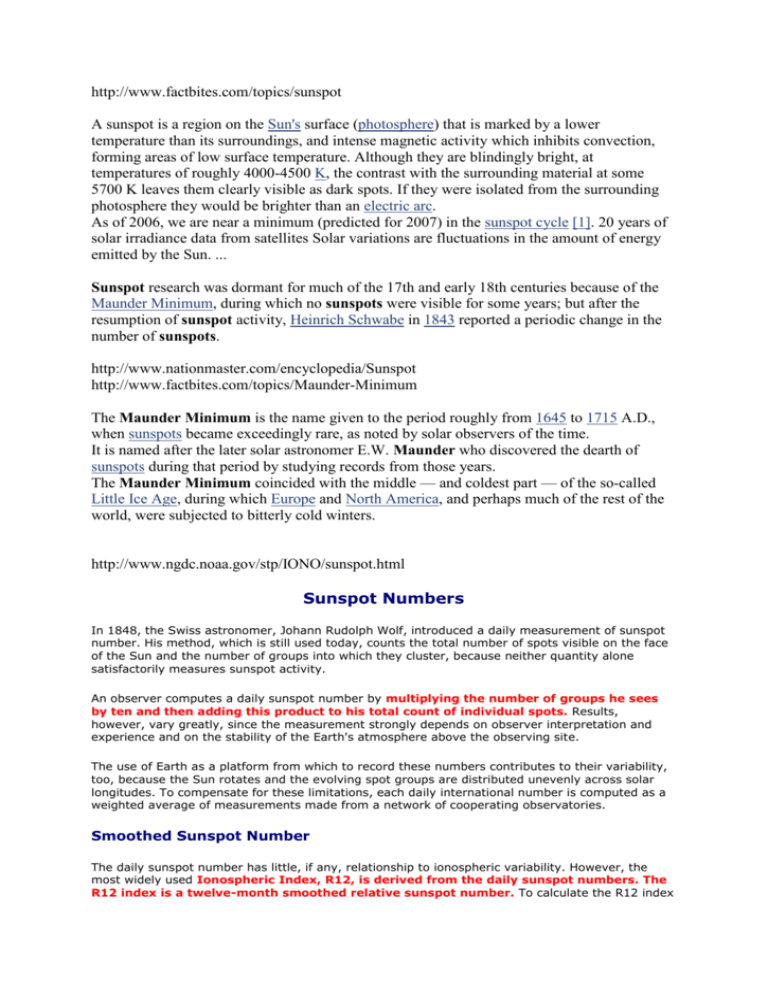
http://www.factbites.com/topics/sunspot A sunspot is a region on the Sun's surface (photosphere) that is marked by a lower temperature than its surroundings, and intense magnetic activity which inhibits convection, forming areas of low surface temperature. Although they are blindingly bright, at temperatures of roughly 4000-4500 K, the contrast with the surrounding material at some 5700 K leaves them clearly visible as dark spots. If they were isolated from the surrounding photosphere they would be brighter than an electric arc. As of 2006, we are near a minimum (predicted for 2007) in the sunspot cycle [1]. 20 years of solar irradiance data from satellites Solar variations are fluctuations in the amount of energy emitted by the Sun. ... Sunspot research was dormant for much of the 17th and early 18th centuries because of the Maunder Minimum, during which no sunspots were visible for some years; but after the resumption of sunspot activity, Heinrich Schwabe in 1843 reported a periodic change in the number of sunspots. http://www.nationmaster.com/encyclopedia/Sunspot http://www.factbites.com/topics/Maunder-Minimum The Maunder Minimum is the name given to the period roughly from 1645 to 1715 A.D., when sunspots became exceedingly rare, as noted by solar observers of the time. It is named after the later solar astronomer E.W. Maunder who discovered the dearth of sunspots during that period by studying records from those years. The Maunder Minimum coincided with the middle — and coldest part — of the so-called Little Ice Age, during which Europe and North America, and perhaps much of the rest of the world, were subjected to bitterly cold winters. http://www.ngdc.noaa.gov/stp/IONO/sunspot.html Sunspot Numbers In 1848, the Swiss astronomer, Johann Rudolph Wolf, introduced a daily measurement of sunspot number. His method, which is still used today, counts the total number of spots visible on the face of the Sun and the number of groups into which they cluster, because neither quantity alone satisfactorily measures sunspot activity. An observer computes a daily sunspot number by multiplying the number of groups he sees by ten and then adding this product to his total count of individual spots. Results, however, vary greatly, since the measurement strongly depends on observer interpretation and experience and on the stability of the Earth's atmosphere above the observing site. The use of Earth as a platform from which to record these numbers contributes to their variability, too, because the Sun rotates and the evolving spot groups are distributed unevenly across solar longitudes. To compensate for these limitations, each daily international number is computed as a weighted average of measurements made from a network of cooperating observatories. Smoothed Sunspot Number The daily sunspot number has little, if any, relationship to ionospheric variability. However, the most widely used Ionospheric Index, R12, is derived from the daily sunspot numbers. The R12 index is a twelve-month smoothed relative sunspot number. To calculate the R12 index for July 1980 add half of the Jan 1980 value plus the sum of the Feb through Dec 1980 values plus half of the Jan 1981 value and by divide the sum twelve: [(n1/2)+(n2+n3+........n11+n12)+(n13/2)]/12 (where n1 = Jan 1980, n7 = July 1980 and n13 = Jan 1981) Today, much more sophisticated measurements of solar activity are made routinely, but none has the link with the past that sunspot numbers have. http://www.ngdc.noaa.gov/stp/SOLAR/SSN/ssn.html Johann Rudolph Wolf (1816-1893). National Portrait Gallery, Smithsonian Institution, Washington D.C. In 1848 Rudolph Wolf devised a daily method of estimating solar activity by counting the number of individual spots and groups of spots on the face of the sun. Wolf chose to compute his sunspot number by adding 10 times the number of groups to the total count of individual spots, because neither quantity alone completely captured the level of activity. Today, Wolf sunspot counts continue, since no other index of the sun's activity reaches into the past as far and as continuously. An avid astronomical historian and an unrivalled expert on sunspot lore, Wolf confirmed the existence of a cycle in sunspot numbers. He also more accurately determined the cycle's length to be 11.1 years by using early historical records. Wolf, who became director of the Zurich Observatory, discovered independently the coincidence of the sunspot cycle with disturbances in the earth's magnetic field. How Sunspot Numbers are Computed Today An observer computes a daily sunspot number by multiplying the number of groups he/she sees by ten and then adding this product to his total count of individual spots, same way that Wolf did. Many refer to the sunspot number as a Wolf number or count (or as a Zurich Sunspot Number). Results, however, vary greatly, since the measurement strongly depends on observer interpretation and experience and on the stability of the Earth's atmosphere above the observing site. Moreover, the use of Earth as a platform from which to record these numbers contributes to their variability, too, because the sun rotates and the evolving spot groups are distributed unevenly across solar longitudes. To compensate for these limitations, each daily international number is computed as a weighted average of measurements made from a network of cooperating observatories. Click on image to see the full-resolution plot. Annual Mean Sunspot Numbers 1700-1995. Sunspot counts rise and fall approximately every 11.1 years. The cycle, though, is not symmetrical, for the spot count takes on the average about 4.8 years to rise from a minimum to a maximum and another 6.2 years to fall to a minimum once again. The largest annual mean number (190.2) occurred in 1957. Today, much more sophisticated measurements of solar activity are made routinely, but none has the link with the past that sunspot numbers have. http://www.sec.noaa.gov/info/FAQ.html c:/DIAS/GIFINTWP200_esa_Reff.pdf Reff is chosen to give the best fit between model calculation and actual measurements. The sunspot number giving the minimum mean square error is called the effective sunspot number, Reff . The mean square error is calculated: Formel… … Where n is the number of stations, foF2obsi is the observed foF2 at station i foF2cali is the calculated foF2 at station i foF2cali is calculated for different sunspot numbers to determine the minimum mean square error and thus Reff. DIAS Glossary Smoothed Sunspot Number (SSN) An average of monthly sunspot numbers centred on the month of concern. There are various formulas, however, the aim is to smooth discrete data points. Solar index R12 The 12-monthly smoothed sunspot number R adopted following ITU-R Recommendations. Solar index Reff The effective sunspot number calculated using real-time foF2 observations. An effective sunspot number Reff, calculated by a method described by Houminer et al. (1993). Reff is the equivalent R12 index, chosen to give the best fit between model (SIRM) calculation and actual foF2 measurements obtained from the grid of DIAS ionosondes. Solar index Reff (SSN in the plot) is the effective sunspot number calculated using real-time foF2 observations. In general, Reff reflects the level of ionospheric activity over Europe regarding the foF2 characteristic. http://www.esaspaceweather.net/spweather/workshops/spw_w5/proceedings/GIFINTWP200_esa.pdf http://www.itu.int/opb/publications.aspx?lang=en&parent=R-REC&selection=4&sector= ITU International Telecommunication Union
